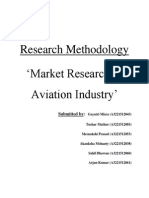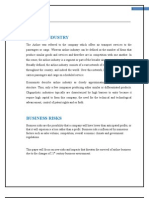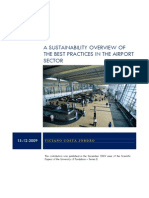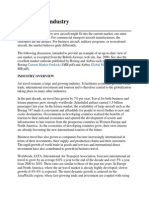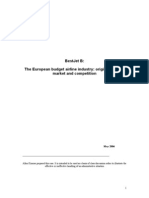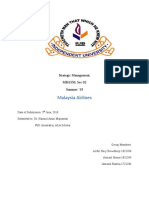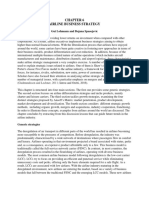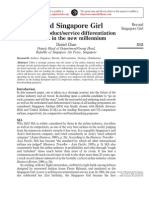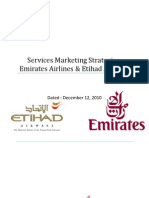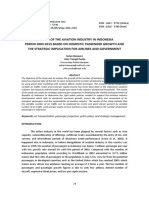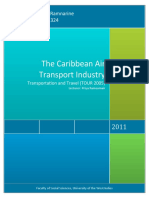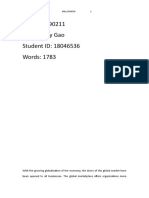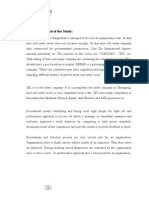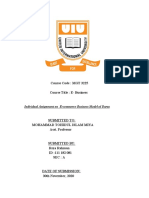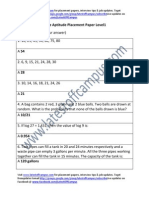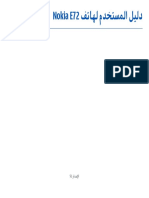Chapter One
Introduction
1.1 background of the study
In globally , The airline industry encompasses various businesses, called airlines, which offer air
transport services for paying customers or business partners. These air transport services are
provided for both human travelers and cargo, and are most commonly offered via jets, although
some airlines also use helicopters (By Martijn Barten, Jun 06, 2024) .The UK domestic aviation
market represents a relatively small proportion of total UK aviation sector – only 8.5% of total
terminal passengers in 2016 (DfT, 2017). Between 2006 and 2016 domestic aviation activity has
fallen by 13% whilst overall UK aviation activity has grown 17.8%. UK domestic air routes are
diverse and range from feeder routes between UK regions and London Heathrow, inter- and
intra-regional air routes and small public transport operations supported by public subsidy
(Public Service Obligation). (Rouncivell, A., Timmis, A., Ison, S.G, (2018)) The Airline Business
in the Twenty-first Century focuses on the major issues that will affect the airline industry as we enter a
new millennium. It tells of an industry working on low margins, of cut-throat competition resulting from
‘open skies’. It analyses the low-cost airlines, the impact of electronic commerce and fuels the debate on
global airline alliances. airline industry is inherently unstable because it is an industry which is constantly
buffeted by new developments and constraints – regulatory, For the then Chairman of Air France, 1993
was an unhappy time. Every evening, as he left his office to go home, his airline had lost another US$4
million! This went on, day in day out, for a year or so. Of course, it was not quite like that. But by the end
of that financial year, his airline had lost almost US$1.5 billion. Such figures graphically illustrate the
depth of the crisis faced by the world’s airlines in the early 1990s. This was a bad time for the airline
business. While the years 1987 to 1989 had been highly profitable, in the period 1990–93 the airline
industry faced the worst crisis it had ever known. The crisis started early in 1990 as fuel prices began to
rise in real terms while a worsening economic climate in several countries, notably the USA and Britain,
began to depress demand in certain markets. The invasion of Kuwait on 2 August 1990 and the short war
that followed in January 1991 turned crisis into disaster for many airlines. Eastern Airlines in the United
States and the British airline Air Europe collapsed early in 1991 while Pan American and several smaller
airlines such as Midway in the United States and TEA in Belgium had gone by the end of the year. The
end of the Gulf War early in 1991 did not lead to any improvement in airline fortunes, since the
�underlying problem was the slowdown in several key economies, not the war. In many markets, such as
the North Atlantic, liberalisation combined with inadequate traffic growth was resulting in overcapacity
and falling yields as airlines fought for market share. Financial results in 1992 were worse than in 1991,
and 1993 was little better. Of the world’s twenty largest airlines, only British Airways, Cathay, SIA
(Singapore Airlines) and Swissair made a net surplus in each of the three years 1991 to 1993. It was the
North American carriers that posted the largest losses in this period. Conversely several Asian airlines
continued to operate profitably. A number of airlines required massive injections of capital to survive
through the early 1990s, particularly Europe’s state-owned airlines such as Air France. Those from
member states of the European Union received . The airline business in the twenty-first century US$10.4
billion in ‘state aid’ in the period up to 1995. This was government funding provided after approval by the
European Commission. Later in 1997 Alitalia was given $1.7 billion of state aid. In addition several
airlines received government funds of various kinds totalling nearly $1.3 billion but not categorised by
the European Commission as ‘state aid’. Even privatised European airlines received capital injections
from their shareholders through rights issues during this period (Chapter 8, Table 8.4). Outside Europe
most state-owned airlines needed direct or indirect government subsidies to keep going. After 1994 as the
cost-cutting measures launched in the crisis years began to have an impact and as demand growth began
to pick up, many airlines returned to profit. This improving trend continued in 1995, 1996 and 1997. Of
the larger carriers two groups, the major Japanese carriers and the stateowned airlines of southern Europe,
performed less well than their counterparts and several, such as Japan Airlines and Alitalia, continued to
make losses. Overall, however, these were boom years for the airline industry. In absolute terms 1998
was the most profitable year ever. The significant improvements in airline profit levels in the mid-1990s
reflected the cyclical pattern that appears to characterise the airline industry (Figure 1.1). Four to six years
of reasonable profits are followed by three or four years of marginal profits or losses. While the overall
profits in the period 1994–97 appear to be higher than those of the corresponding period in the 1980s, the
profit margins (i.e. profits as a percentage of revenues) are no better (Figure 1.2). However, even in the
good years profit margins are low. The net profits, after interest and tax, rarely achieve even 2 per cent of
revenues. In 1998, the best year in absolute terms, the net operating result was only 3 per cent. Clearly,
the airline industry is not very profitable compared to other industries. Of course some airlines, as
previously mentioned, performed much better than the average. But even they rarely achieved a 10 per
cent operating margin. Despite the overall improvement in airline financial performance after 1994,
airlines had become increasingly indebted as they borrowed heavily to finance their losses or to pay for
aircraft ordered in the good years of the late 1980s. As a result, during the 1990s interest payments rose
alarmingly. Many airlines, while making an operating surplus, were pushed into the red as a result of their
large interest payments. The total interest payments that had to be paid each year rose dramatically during
�this period and were an indication of the industry’s growing indebtedness. Annual interest payments for
the international operations of IATA’s member airlines doubled from $1.8 billion in 1988 to $3.6 billion
in 1992 and have remained at over $3 billion per annum since then. This is so despite the huge writeoff of
debts among many state-owned airlines in Europe who used their ‘state aid’ primarily to cancel some of
their accumulated debts.. (Doganis, 2001 ).
In Africa
strategies for African airlines to overcome such challenges. A whole range of problems persist in Africa
that include: high costs; poor safety; government interference; corruption; low productivity and
overstaffing; old aircraft; sparse demand over long sectors; low load factors; strong travel agent networks
that operate in a cash economy; last minute booking profiles; low internet penetration; skills shortage; and
difficulty in obtaining Air Operating Certificates (AOCs). These are all threats that need to be mitigated
by African airlines if they are to remain economically sustainable, and will shape any conclusions on
sustainable business models on the continent. Over the last decade, 37 airlines have launched in Africa
and 37 have failed (Kamara, 2012) – the problems facing the aviation landscape within Africa are
extensive (Heinz, S. and O'Connell, 2013)
the domestic passenger airline business in South Africa has seen tremendous rise in load factors
(Haarhoff, 2017). In 1990, nine airlines entered the domestic passenger market, with six joining after
2010 (R.-J. Luke, 2015; Nkululeko, 2020; Paelo, 2015). The national air carrier (South African Airlines)
enjoyed some monopoly on the high-density routes before domestic market deregulation, while Comair',
Link Airways, and Bop Air were operating on the feeder routes (Mhlanga, 2017). However, after
deregulation Slabbert (2015) predicts that South African Airways' (SAA) market share will plummet from
over 90% in 1994 to less than 50% today. Whereas, as a result of socio-economic changes, the passenger
market has grown in South Africa (Campbell et al., 2012; Mbura, 2020). It is our employees who have
made it possible for Ethiopian to continuously register an average growth of 20 percent to 25 percent per
year in all operational parameters over the last decade. Just to give an example, in 2004 we were making
$390 million in revenue. In 2013, we had a turnover of close to $2.5 billion, becoming the largest African
airline (WENSVEEN, 2015).
In somalia
the Somali government established Somali Airlines in 1964 as a joint venture with Alitalia, an
Italian national airline. Alitalia was responsible for providing management services, technical
support, and training for Somali aviation personnel. Somali Airlines operated both domestic and
�international flights, with routes extending to Europe, the Middle East, and Africa (Table 2). In
the same period, Somalia joined the ICAO and signed the International Services Transit
Agreement (Kaplan, 1969).The outbreak of the civil war in Somalia in 1991 had a devastating
impact on the aviation industry, leading to severe disruptions and destruction of aviation
infrastructure. Consequently, Somali Airlines ceased operations, and private airlines, such as
daallo Airlines and Jubba Airways, emerged to fill the void (Garowe Online, 2022 .
(Hussei, June 2024) studied that The Assessment of Safety Performance in the Civil Aviation
airplane industry (Farah, 6(1) (2024)) studied that The role of quality in airport services in
passenger satisfaction at Aden Adde International Airport, Mogadishu, Somalia .so it can bee
seen these above studies did not investigate the airline side pricing strategy.
Independenty variable in this study : pricing strategy. A pricing strategy has as goal to establish an
optimum price with current profit maximization, maximization of the number of units sold (Alexandre
Dolgui, Jean-Marie Proth, 2010).pricing strategies Any firm who has this as a pricing strategy must be
ready to operate and plan on the long run. It is quite different from target return which might deceptive
because a firm could be earning but losing market share gradually (Lancaster, et al., 2002). Pricing
strategy is paramount to every organization involved in the production of consumer goods and services
because it gives a cue about the company and its products, a company does not set a single price but
rather a pricing structure that covers different items in its line (Kotler et al, 2001). According to
Hinterhuber (2008) pricing strategies vary considerably across industries, countries and customers and
can be categorized into three groups: cost-based pricing, competition-based pricing, and customer value-
based pricing (Dudu Oritsematosan Faith, Awgu M. Edwin, 2, August 2014) there are many ways
measure pricing strategy but these studies measure what effect pricing strategy in ticket airplane the side
of ,fuel,service and geographical,people
Dependent variable of the study is airline industry: Over the past 60 years, the air transportation industry
has become an increasingly important part of the U.S. economy. Aviation is the nation’s dominant
intercity mode of transportation for those passengers and goods that must be transported quickly and
efficiently (WENSVEEN, Air Transportation A Management Perspective, 2015) Airports serve a crucial
role within the air transport system as they provide essential infrastructure for the seamless transition of
people and freight between ground and air modes, as well as facilitating the operation of flights by
airlines. (Graham, 2018). The third important development is the option of purchasing airline tickets on
the internet. In 1996, most tickets were sold through the airline’s reservation office or traditional travel
agencies, with less than 0.5% sold online By 2007, online sales accounted for 26% of global sales, and as
�high as 50-60% in U.S.6 The proliferation of online sites that provided information (Steven Berry and
Panle Jia, November 2008) but in this study measure airlane industries factors fluctuation ticket prices
so! This thesis focus on why ticket airlanes changing price ?.in somalia ,this problem reported population
using airlanes. that’s why writing this study.
1.2 problem statement
If the prices of airplanes were to be constant and people were satisfied what happened? many
people following the planes because the price is not fearing,airline industries increase flights
because increase needed of airplanes ,increase competitions of airplane industries because to
attractive a lot of customers. Investigate now the price is fluctuating which is a big problem for
the society ,high price of the airplanes at this time is the reason why the society does not take the
airplanes,examine if not solution a problem result increased travel costs that’s cause discourging
travels and difficult for travelers price paid, reduce customers confidence that’s cause fluctuating
prices can create uncertainly ,therefore the problem that this study addressed the investigate the
elements which find price stability to measure 1.price transparency 2.fair pricing
practices,3.consumer protection,fuel surcharge regulation and 5.dynamic pricing oversight
1.3 objectives of the study
1.To assess the relationship between price taransparency and airplanes in Puntland .somalia
2.To find out the relationship between services and airplanes in Puntland. somalia
1.4 purpose of the study
The purpose of the study is to investigate relationship between pricing strategy and airplanes in
Puntland ,somalia
1.5 research questions
1.what is the relationship does the service have with and airplanes ?
2.what is the relationship does the price transparency and airplanes ?
3.what is the relation ship does the travels and airplanes?
1.6 scope of the study
The study will concentrate on competition and operational costs,in airlanes of the world.in content value-
based pricing and population satisfaction and their relationship with airlanes among customers of airports
in a world and the study will carried out November to may 2025




